Employment Relationship Management Unit 4 - Desklib
VerifiedAdded on 2023/06/17
|16
|4613
|275
AI Summary
This report discusses employment relationship management and highlights various approaches to employee voice & organizational performance. It also includes an assessment of emerging trends in conflicts and industrial sanctions.
Contribute Materials
Your contribution can guide someone’s learning journey. Share your
documents today.
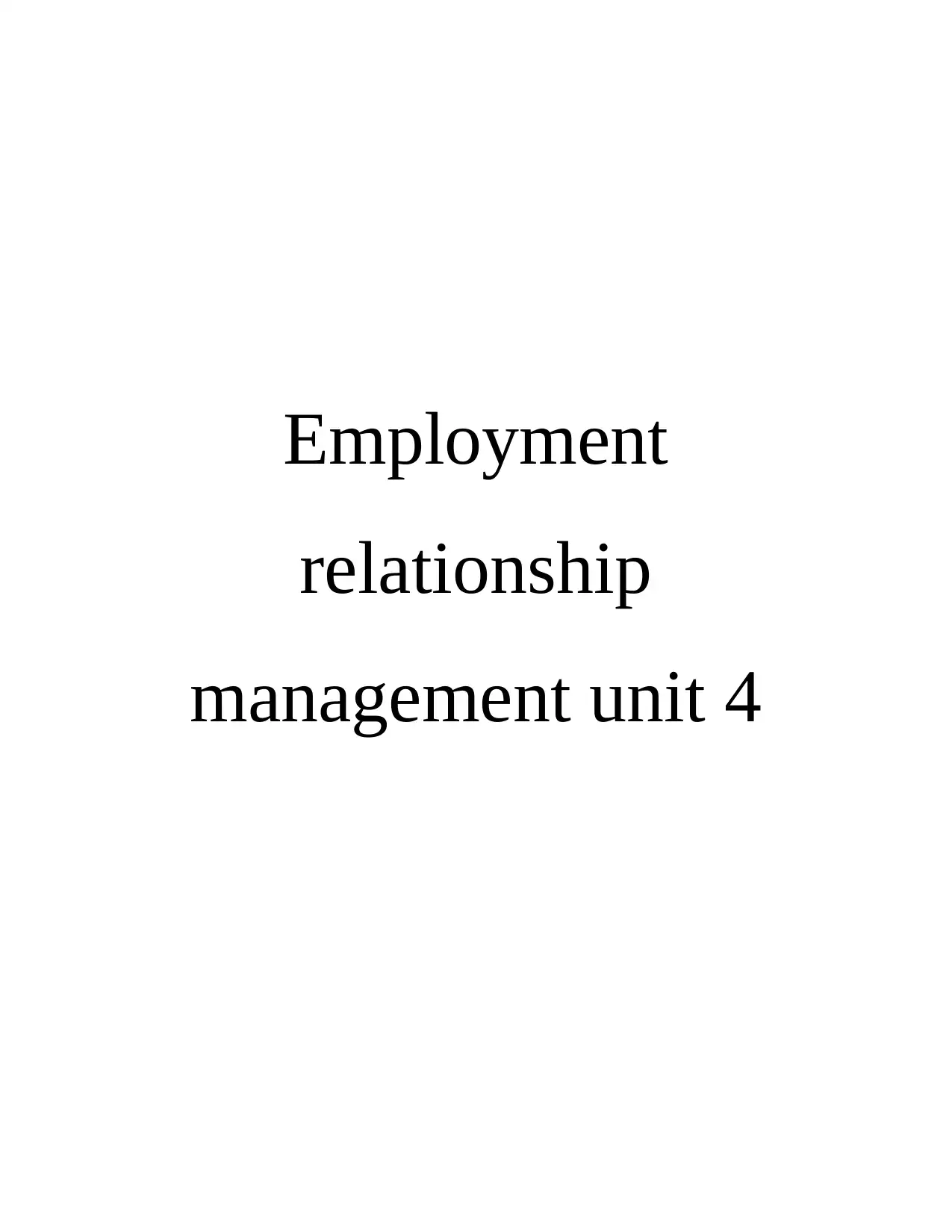
Employment
relationship
management unit 4
relationship
management unit 4
Secure Best Marks with AI Grader
Need help grading? Try our AI Grader for instant feedback on your assignments.
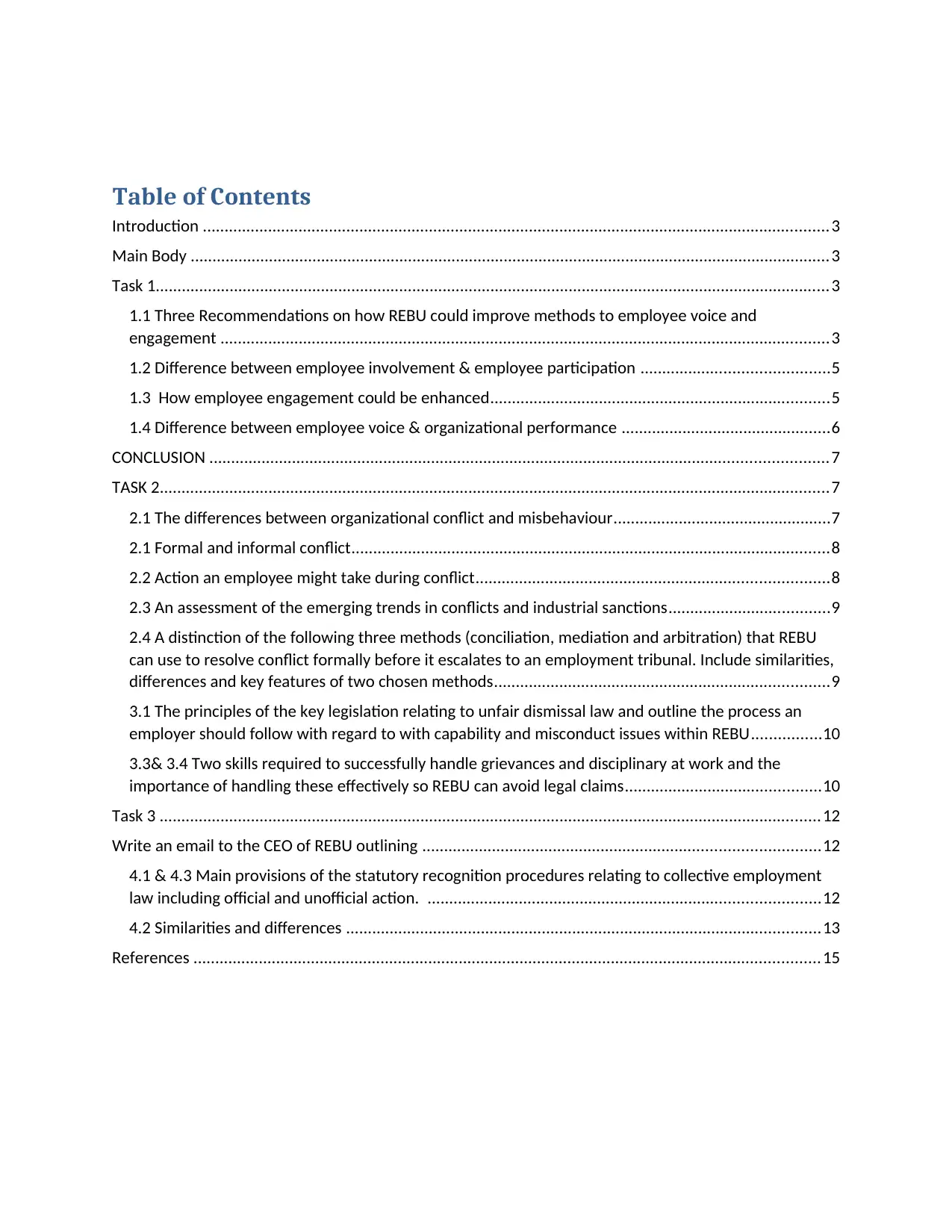
Table of Contents
Introduction ................................................................................................................................................3
Main Body ...................................................................................................................................................3
Task 1...........................................................................................................................................................3
1.1 Three Recommendations on how REBU could improve methods to employee voice and
engagement ............................................................................................................................................3
1.2 Difference between employee involvement & employee participation ...........................................5
1.3 How employee engagement could be enhanced..............................................................................5
1.4 Difference between employee voice & organizational performance ................................................6
CONCLUSION ..............................................................................................................................................7
TASK 2..........................................................................................................................................................7
2.1 The differences between organizational conflict and misbehaviour..................................................7
2.1 Formal and informal conflict..............................................................................................................8
2.2 Action an employee might take during conflict.................................................................................8
2.3 An assessment of the emerging trends in conflicts and industrial sanctions.....................................9
2.4 A distinction of the following three methods (conciliation, mediation and arbitration) that REBU
can use to resolve conflict formally before it escalates to an employment tribunal. Include similarities,
differences and key features of two chosen methods.............................................................................9
3.1 The principles of the key legislation relating to unfair dismissal law and outline the process an
employer should follow with regard to with capability and misconduct issues within REBU................10
3.3& 3.4 Two skills required to successfully handle grievances and disciplinary at work and the
importance of handling these effectively so REBU can avoid legal claims.............................................10
Task 3 ........................................................................................................................................................12
Write an email to the CEO of REBU outlining ...........................................................................................12
4.1 & 4.3 Main provisions of the statutory recognition procedures relating to collective employment
law including official and unofficial action. ..........................................................................................12
4.2 Similarities and differences .............................................................................................................13
References ................................................................................................................................................15
Introduction ................................................................................................................................................3
Main Body ...................................................................................................................................................3
Task 1...........................................................................................................................................................3
1.1 Three Recommendations on how REBU could improve methods to employee voice and
engagement ............................................................................................................................................3
1.2 Difference between employee involvement & employee participation ...........................................5
1.3 How employee engagement could be enhanced..............................................................................5
1.4 Difference between employee voice & organizational performance ................................................6
CONCLUSION ..............................................................................................................................................7
TASK 2..........................................................................................................................................................7
2.1 The differences between organizational conflict and misbehaviour..................................................7
2.1 Formal and informal conflict..............................................................................................................8
2.2 Action an employee might take during conflict.................................................................................8
2.3 An assessment of the emerging trends in conflicts and industrial sanctions.....................................9
2.4 A distinction of the following three methods (conciliation, mediation and arbitration) that REBU
can use to resolve conflict formally before it escalates to an employment tribunal. Include similarities,
differences and key features of two chosen methods.............................................................................9
3.1 The principles of the key legislation relating to unfair dismissal law and outline the process an
employer should follow with regard to with capability and misconduct issues within REBU................10
3.3& 3.4 Two skills required to successfully handle grievances and disciplinary at work and the
importance of handling these effectively so REBU can avoid legal claims.............................................10
Task 3 ........................................................................................................................................................12
Write an email to the CEO of REBU outlining ...........................................................................................12
4.1 & 4.3 Main provisions of the statutory recognition procedures relating to collective employment
law including official and unofficial action. ..........................................................................................12
4.2 Similarities and differences .............................................................................................................13
References ................................................................................................................................................15
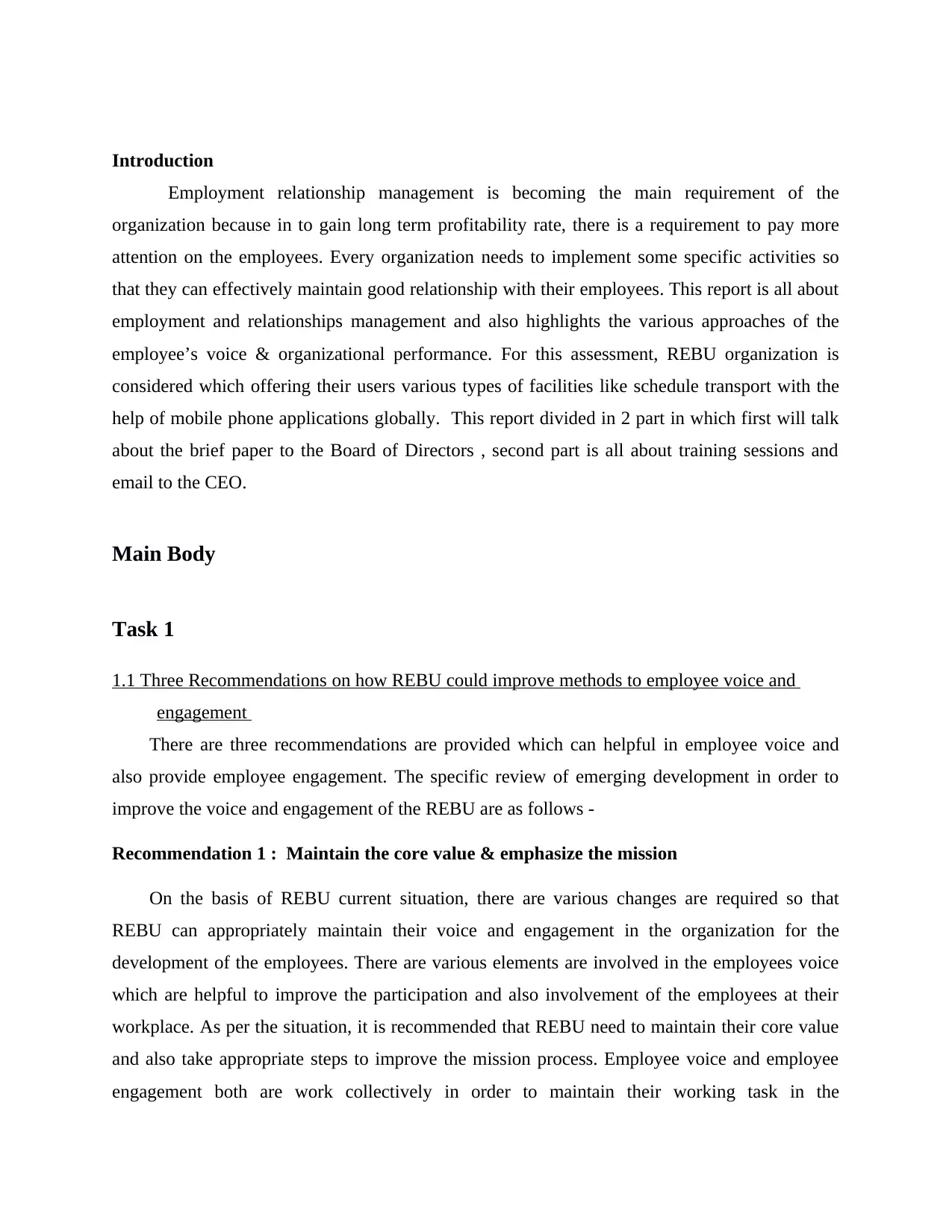
Introduction
Employment relationship management is becoming the main requirement of the
organization because in to gain long term profitability rate, there is a requirement to pay more
attention on the employees. Every organization needs to implement some specific activities so
that they can effectively maintain good relationship with their employees. This report is all about
employment and relationships management and also highlights the various approaches of the
employee’s voice & organizational performance. For this assessment, REBU organization is
considered which offering their users various types of facilities like schedule transport with the
help of mobile phone applications globally. This report divided in 2 part in which first will talk
about the brief paper to the Board of Directors , second part is all about training sessions and
email to the CEO.
Main Body
Task 1
1.1 Three Recommendations on how REBU could improve methods to employee voice and
engagement
There are three recommendations are provided which can helpful in employee voice and
also provide employee engagement. The specific review of emerging development in order to
improve the voice and engagement of the REBU are as follows -
Recommendation 1 : Maintain the core value & emphasize the mission
On the basis of REBU current situation, there are various changes are required so that
REBU can appropriately maintain their voice and engagement in the organization for the
development of the employees. There are various elements are involved in the employees voice
which are helpful to improve the participation and also involvement of the employees at their
workplace. As per the situation, it is recommended that REBU need to maintain their core value
and also take appropriate steps to improve the mission process. Employee voice and employee
engagement both are work collectively in order to maintain their working task in the
Employment relationship management is becoming the main requirement of the
organization because in to gain long term profitability rate, there is a requirement to pay more
attention on the employees. Every organization needs to implement some specific activities so
that they can effectively maintain good relationship with their employees. This report is all about
employment and relationships management and also highlights the various approaches of the
employee’s voice & organizational performance. For this assessment, REBU organization is
considered which offering their users various types of facilities like schedule transport with the
help of mobile phone applications globally. This report divided in 2 part in which first will talk
about the brief paper to the Board of Directors , second part is all about training sessions and
email to the CEO.
Main Body
Task 1
1.1 Three Recommendations on how REBU could improve methods to employee voice and
engagement
There are three recommendations are provided which can helpful in employee voice and
also provide employee engagement. The specific review of emerging development in order to
improve the voice and engagement of the REBU are as follows -
Recommendation 1 : Maintain the core value & emphasize the mission
On the basis of REBU current situation, there are various changes are required so that
REBU can appropriately maintain their voice and engagement in the organization for the
development of the employees. There are various elements are involved in the employees voice
which are helpful to improve the participation and also involvement of the employees at their
workplace. As per the situation, it is recommended that REBU need to maintain their core value
and also take appropriate steps to improve the mission process. Employee voice and employee
engagement both are work collectively in order to maintain their working task in the

organization. There are some appropriate steps need to adopted by the REBU , like collective
representation, proper communication, upward communication, suggestion scheme, quality circle
and jointly consultation. All these things are helpful to improve the involvement of the
employees and also enhance their voice and engagement in the organization (Opoku‐Dakwa,
Chen and Rupp, 2018).
Recommendation 2: Priorities Feedback and concentrate on the engaging management
In order to improve the employee engagement in REBU, it is necessary for the company to
provide their employees proper feedback and also focus on the emerging management so that
company can appropriately improve the effectiveness of their staff members. It is recommended
that company need to improve their development process and also maintain their performance as
per the requirement of the firm. It is analyzed that constant feedback is helpful to improve the
performance and productivity level of the staff members so that they can work effectively and
constantly as per to improve their performance level as compared to the previous performance.
REBU is operating their business internationally so it is necessary for the company to you take
care about their employees so that they can easily interact with the customers and clients and also
address their requirement effectively. Manager of the company needs to formulate some specific
Strategies and also maintain appropriate process in order to improve the management system and
the whole organizational (Anthony‐McMann and et. al., 2017). With the help of effective
management system, all the employees can easily communicate with their superior and
subordinate and also take their precious suggestions and feedback in order to update themselves
and improve their performance graph (Butler, 2018).
Recommendation 3: Conduct employees engagement survey constantly
On the basis of present situation of REBU , it is recommended that there is a need to tu to
conduct a small scale survey continuously. With the help of employee engagement survey,
manager of the REBU can appropriately generalize the prospective and viewpoint of their
employees with the help of employee engagement survey, company can identify the problem,
issues and prospective of their employees so that company can easily do the modification in
representation, proper communication, upward communication, suggestion scheme, quality circle
and jointly consultation. All these things are helpful to improve the involvement of the
employees and also enhance their voice and engagement in the organization (Opoku‐Dakwa,
Chen and Rupp, 2018).
Recommendation 2: Priorities Feedback and concentrate on the engaging management
In order to improve the employee engagement in REBU, it is necessary for the company to
provide their employees proper feedback and also focus on the emerging management so that
company can appropriately improve the effectiveness of their staff members. It is recommended
that company need to improve their development process and also maintain their performance as
per the requirement of the firm. It is analyzed that constant feedback is helpful to improve the
performance and productivity level of the staff members so that they can work effectively and
constantly as per to improve their performance level as compared to the previous performance.
REBU is operating their business internationally so it is necessary for the company to you take
care about their employees so that they can easily interact with the customers and clients and also
address their requirement effectively. Manager of the company needs to formulate some specific
Strategies and also maintain appropriate process in order to improve the management system and
the whole organizational (Anthony‐McMann and et. al., 2017). With the help of effective
management system, all the employees can easily communicate with their superior and
subordinate and also take their precious suggestions and feedback in order to update themselves
and improve their performance graph (Butler, 2018).
Recommendation 3: Conduct employees engagement survey constantly
On the basis of present situation of REBU , it is recommended that there is a need to tu to
conduct a small scale survey continuously. With the help of employee engagement survey,
manager of the REBU can appropriately generalize the prospective and viewpoint of their
employees with the help of employee engagement survey, company can identify the problem,
issues and prospective of their employees so that company can easily do the modification in
Secure Best Marks with AI Grader
Need help grading? Try our AI Grader for instant feedback on your assignments.
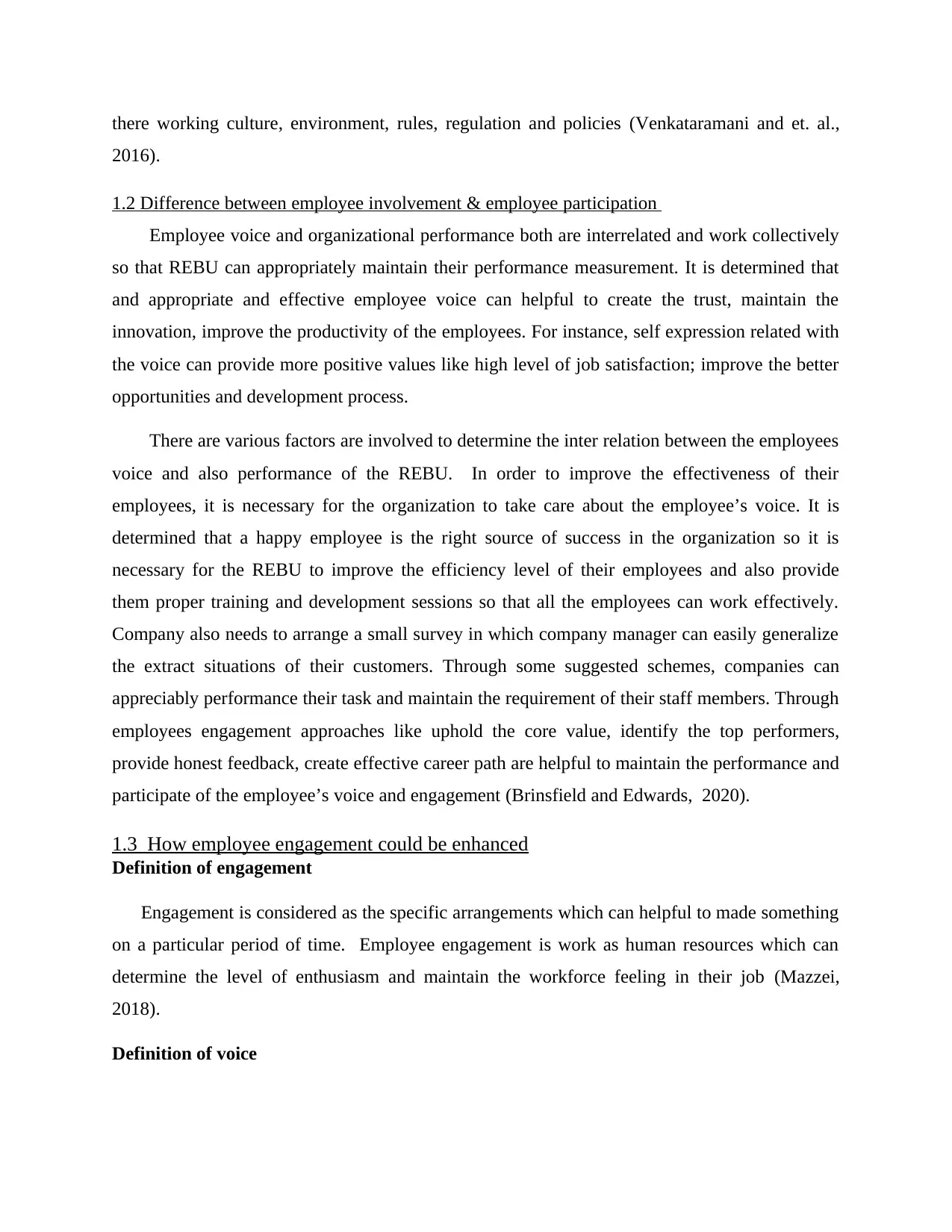
there working culture, environment, rules, regulation and policies (Venkataramani and et. al.,
2016).
1.2 Difference between employee involvement & employee participation
Employee voice and organizational performance both are interrelated and work collectively
so that REBU can appropriately maintain their performance measurement. It is determined that
and appropriate and effective employee voice can helpful to create the trust, maintain the
innovation, improve the productivity of the employees. For instance, self expression related with
the voice can provide more positive values like high level of job satisfaction; improve the better
opportunities and development process.
There are various factors are involved to determine the inter relation between the employees
voice and also performance of the REBU. In order to improve the effectiveness of their
employees, it is necessary for the organization to take care about the employee’s voice. It is
determined that a happy employee is the right source of success in the organization so it is
necessary for the REBU to improve the efficiency level of their employees and also provide
them proper training and development sessions so that all the employees can work effectively.
Company also needs to arrange a small survey in which company manager can easily generalize
the extract situations of their customers. Through some suggested schemes, companies can
appreciably performance their task and maintain the requirement of their staff members. Through
employees engagement approaches like uphold the core value, identify the top performers,
provide honest feedback, create effective career path are helpful to maintain the performance and
participate of the employee’s voice and engagement (Brinsfield and Edwards, 2020).
1.3 How employee engagement could be enhanced
Definition of engagement
Engagement is considered as the specific arrangements which can helpful to made something
on a particular period of time. Employee engagement is work as human resources which can
determine the level of enthusiasm and maintain the workforce feeling in their job (Mazzei,
2018).
Definition of voice
2016).
1.2 Difference between employee involvement & employee participation
Employee voice and organizational performance both are interrelated and work collectively
so that REBU can appropriately maintain their performance measurement. It is determined that
and appropriate and effective employee voice can helpful to create the trust, maintain the
innovation, improve the productivity of the employees. For instance, self expression related with
the voice can provide more positive values like high level of job satisfaction; improve the better
opportunities and development process.
There are various factors are involved to determine the inter relation between the employees
voice and also performance of the REBU. In order to improve the effectiveness of their
employees, it is necessary for the organization to take care about the employee’s voice. It is
determined that a happy employee is the right source of success in the organization so it is
necessary for the REBU to improve the efficiency level of their employees and also provide
them proper training and development sessions so that all the employees can work effectively.
Company also needs to arrange a small survey in which company manager can easily generalize
the extract situations of their customers. Through some suggested schemes, companies can
appreciably performance their task and maintain the requirement of their staff members. Through
employees engagement approaches like uphold the core value, identify the top performers,
provide honest feedback, create effective career path are helpful to maintain the performance and
participate of the employee’s voice and engagement (Brinsfield and Edwards, 2020).
1.3 How employee engagement could be enhanced
Definition of engagement
Engagement is considered as the specific arrangements which can helpful to made something
on a particular period of time. Employee engagement is work as human resources which can
determine the level of enthusiasm and maintain the workforce feeling in their job (Mazzei,
2018).
Definition of voice
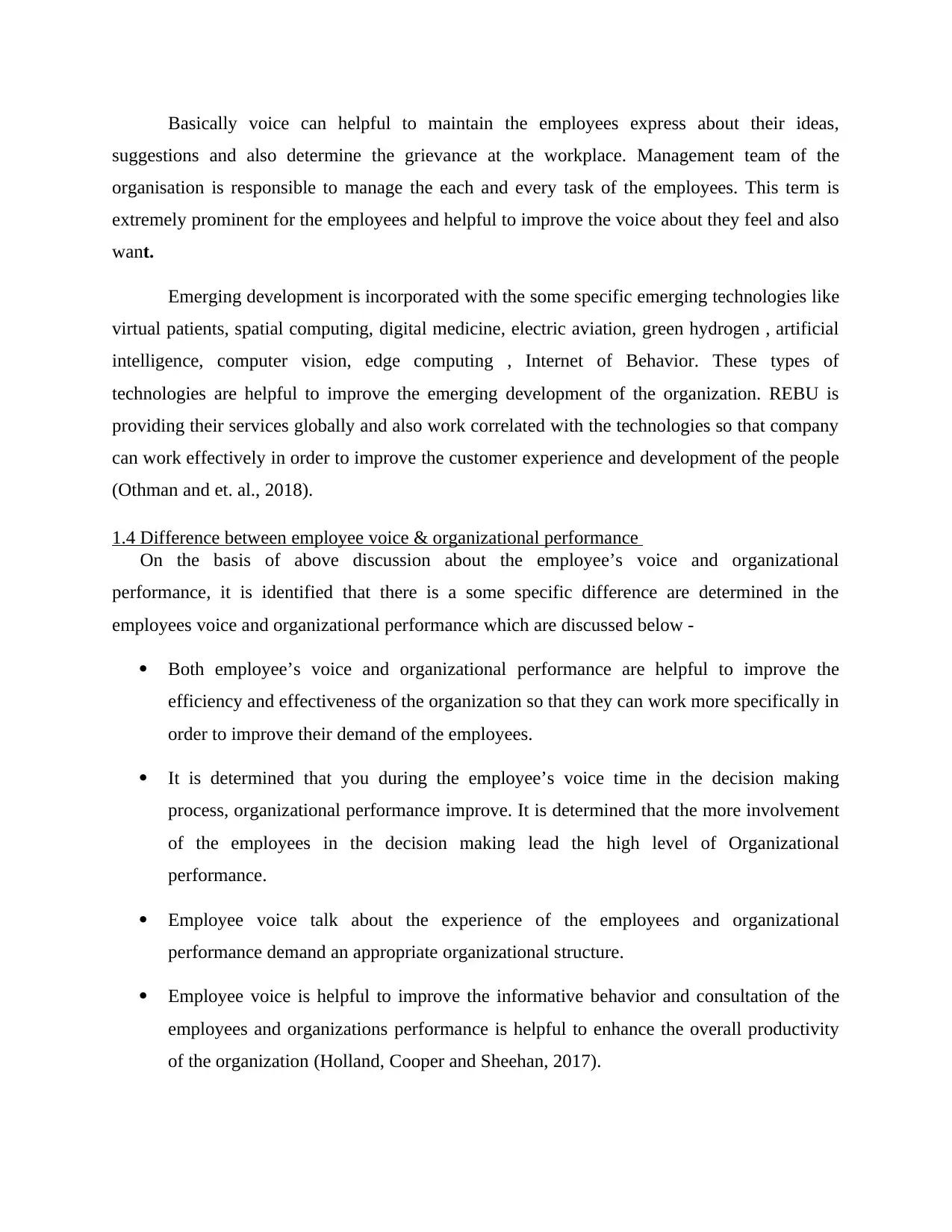
Basically voice can helpful to maintain the employees express about their ideas,
suggestions and also determine the grievance at the workplace. Management team of the
organisation is responsible to manage the each and every task of the employees. This term is
extremely prominent for the employees and helpful to improve the voice about they feel and also
want.
Emerging development is incorporated with the some specific emerging technologies like
virtual patients, spatial computing, digital medicine, electric aviation, green hydrogen , artificial
intelligence, computer vision, edge computing , Internet of Behavior. These types of
technologies are helpful to improve the emerging development of the organization. REBU is
providing their services globally and also work correlated with the technologies so that company
can work effectively in order to improve the customer experience and development of the people
(Othman and et. al., 2018).
1.4 Difference between employee voice & organizational performance
On the basis of above discussion about the employee’s voice and organizational
performance, it is identified that there is a some specific difference are determined in the
employees voice and organizational performance which are discussed below -
Both employee’s voice and organizational performance are helpful to improve the
efficiency and effectiveness of the organization so that they can work more specifically in
order to improve their demand of the employees.
It is determined that you during the employee’s voice time in the decision making
process, organizational performance improve. It is determined that the more involvement
of the employees in the decision making lead the high level of Organizational
performance.
Employee voice talk about the experience of the employees and organizational
performance demand an appropriate organizational structure.
Employee voice is helpful to improve the informative behavior and consultation of the
employees and organizations performance is helpful to enhance the overall productivity
of the organization (Holland, Cooper and Sheehan, 2017).
suggestions and also determine the grievance at the workplace. Management team of the
organisation is responsible to manage the each and every task of the employees. This term is
extremely prominent for the employees and helpful to improve the voice about they feel and also
want.
Emerging development is incorporated with the some specific emerging technologies like
virtual patients, spatial computing, digital medicine, electric aviation, green hydrogen , artificial
intelligence, computer vision, edge computing , Internet of Behavior. These types of
technologies are helpful to improve the emerging development of the organization. REBU is
providing their services globally and also work correlated with the technologies so that company
can work effectively in order to improve the customer experience and development of the people
(Othman and et. al., 2018).
1.4 Difference between employee voice & organizational performance
On the basis of above discussion about the employee’s voice and organizational
performance, it is identified that there is a some specific difference are determined in the
employees voice and organizational performance which are discussed below -
Both employee’s voice and organizational performance are helpful to improve the
efficiency and effectiveness of the organization so that they can work more specifically in
order to improve their demand of the employees.
It is determined that you during the employee’s voice time in the decision making
process, organizational performance improve. It is determined that the more involvement
of the employees in the decision making lead the high level of Organizational
performance.
Employee voice talk about the experience of the employees and organizational
performance demand an appropriate organizational structure.
Employee voice is helpful to improve the informative behavior and consultation of the
employees and organizations performance is helpful to enhance the overall productivity
of the organization (Holland, Cooper and Sheehan, 2017).
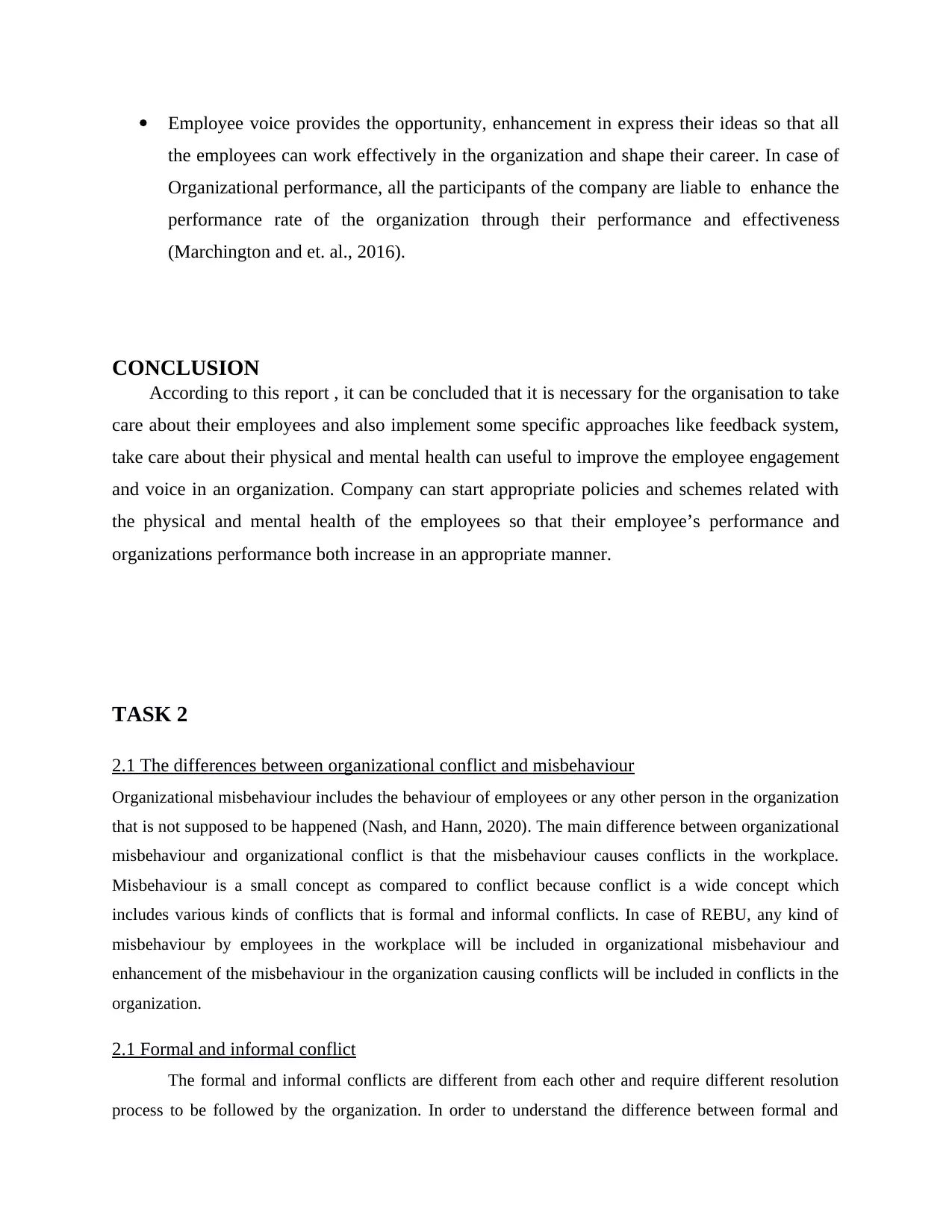
Employee voice provides the opportunity, enhancement in express their ideas so that all
the employees can work effectively in the organization and shape their career. In case of
Organizational performance, all the participants of the company are liable to enhance the
performance rate of the organization through their performance and effectiveness
(Marchington and et. al., 2016).
CONCLUSION
According to this report , it can be concluded that it is necessary for the organisation to take
care about their employees and also implement some specific approaches like feedback system,
take care about their physical and mental health can useful to improve the employee engagement
and voice in an organization. Company can start appropriate policies and schemes related with
the physical and mental health of the employees so that their employee’s performance and
organizations performance both increase in an appropriate manner.
TASK 2
2.1 The differences between organizational conflict and misbehaviour
Organizational misbehaviour includes the behaviour of employees or any other person in the organization
that is not supposed to be happened (Nash, and Hann, 2020). The main difference between organizational
misbehaviour and organizational conflict is that the misbehaviour causes conflicts in the workplace.
Misbehaviour is a small concept as compared to conflict because conflict is a wide concept which
includes various kinds of conflicts that is formal and informal conflicts. In case of REBU, any kind of
misbehaviour by employees in the workplace will be included in organizational misbehaviour and
enhancement of the misbehaviour in the organization causing conflicts will be included in conflicts in the
organization.
2.1 Formal and informal conflict
The formal and informal conflicts are different from each other and require different resolution
process to be followed by the organization. In order to understand the difference between formal and
the employees can work effectively in the organization and shape their career. In case of
Organizational performance, all the participants of the company are liable to enhance the
performance rate of the organization through their performance and effectiveness
(Marchington and et. al., 2016).
CONCLUSION
According to this report , it can be concluded that it is necessary for the organisation to take
care about their employees and also implement some specific approaches like feedback system,
take care about their physical and mental health can useful to improve the employee engagement
and voice in an organization. Company can start appropriate policies and schemes related with
the physical and mental health of the employees so that their employee’s performance and
organizations performance both increase in an appropriate manner.
TASK 2
2.1 The differences between organizational conflict and misbehaviour
Organizational misbehaviour includes the behaviour of employees or any other person in the organization
that is not supposed to be happened (Nash, and Hann, 2020). The main difference between organizational
misbehaviour and organizational conflict is that the misbehaviour causes conflicts in the workplace.
Misbehaviour is a small concept as compared to conflict because conflict is a wide concept which
includes various kinds of conflicts that is formal and informal conflicts. In case of REBU, any kind of
misbehaviour by employees in the workplace will be included in organizational misbehaviour and
enhancement of the misbehaviour in the organization causing conflicts will be included in conflicts in the
organization.
2.1 Formal and informal conflict
The formal and informal conflicts are different from each other and require different resolution
process to be followed by the organization. In order to understand the difference between formal and
Paraphrase This Document
Need a fresh take? Get an instant paraphrase of this document with our AI Paraphraser
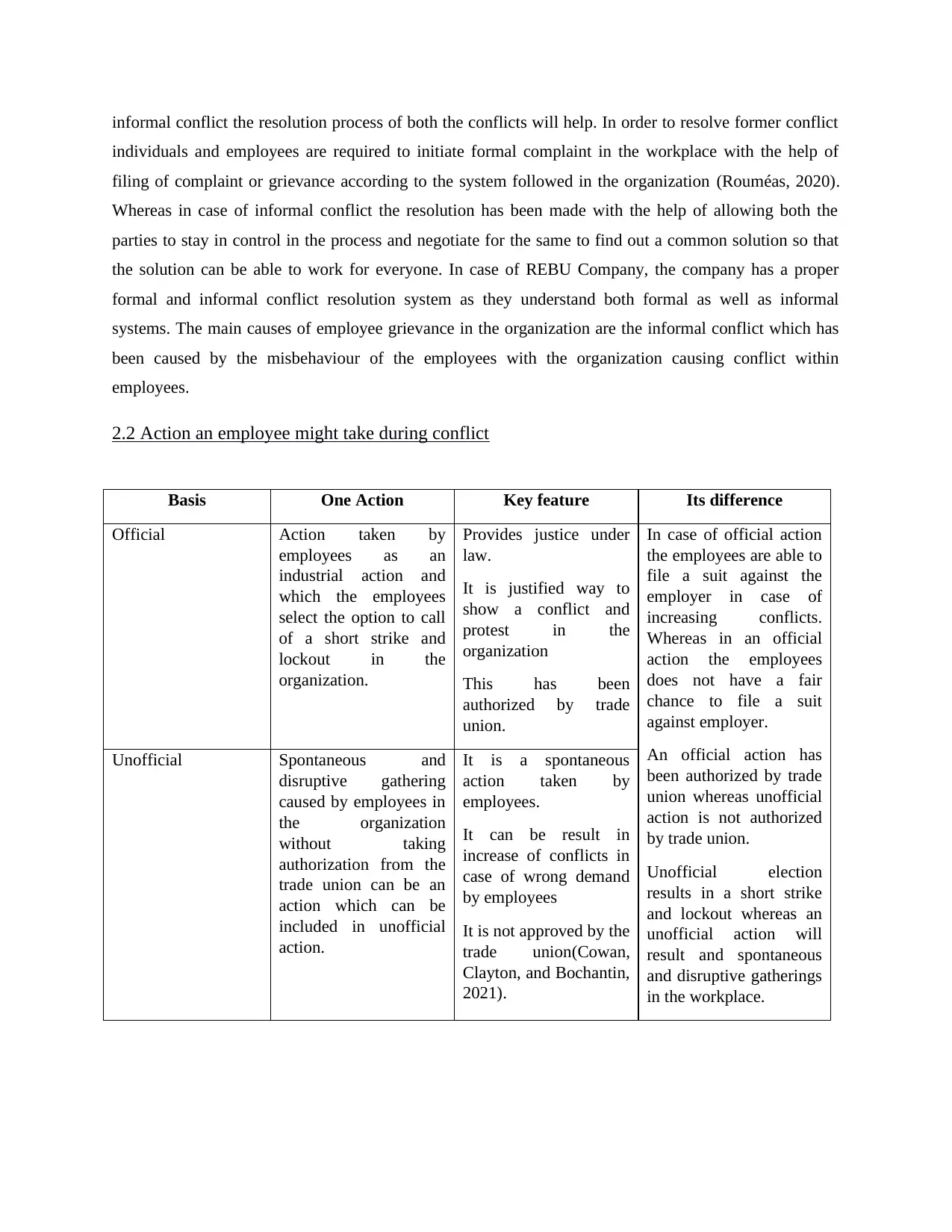
informal conflict the resolution process of both the conflicts will help. In order to resolve former conflict
individuals and employees are required to initiate formal complaint in the workplace with the help of
filing of complaint or grievance according to the system followed in the organization (Rouméas, 2020).
Whereas in case of informal conflict the resolution has been made with the help of allowing both the
parties to stay in control in the process and negotiate for the same to find out a common solution so that
the solution can be able to work for everyone. In case of REBU Company, the company has a proper
formal and informal conflict resolution system as they understand both formal as well as informal
systems. The main causes of employee grievance in the organization are the informal conflict which has
been caused by the misbehaviour of the employees with the organization causing conflict within
employees.
2.2 Action an employee might take during conflict
Basis One Action Key feature Its difference
Official Action taken by
employees as an
industrial action and
which the employees
select the option to call
of a short strike and
lockout in the
organization.
Provides justice under
law.
It is justified way to
show a conflict and
protest in the
organization
This has been
authorized by trade
union.
In case of official action
the employees are able to
file a suit against the
employer in case of
increasing conflicts.
Whereas in an official
action the employees
does not have a fair
chance to file a suit
against employer.
An official action has
been authorized by trade
union whereas unofficial
action is not authorized
by trade union.
Unofficial election
results in a short strike
and lockout whereas an
unofficial action will
result and spontaneous
and disruptive gatherings
in the workplace.
Unofficial Spontaneous and
disruptive gathering
caused by employees in
the organization
without taking
authorization from the
trade union can be an
action which can be
included in unofficial
action.
It is a spontaneous
action taken by
employees.
It can be result in
increase of conflicts in
case of wrong demand
by employees
It is not approved by the
trade union(Cowan,
Clayton, and Bochantin,
2021).
individuals and employees are required to initiate formal complaint in the workplace with the help of
filing of complaint or grievance according to the system followed in the organization (Rouméas, 2020).
Whereas in case of informal conflict the resolution has been made with the help of allowing both the
parties to stay in control in the process and negotiate for the same to find out a common solution so that
the solution can be able to work for everyone. In case of REBU Company, the company has a proper
formal and informal conflict resolution system as they understand both formal as well as informal
systems. The main causes of employee grievance in the organization are the informal conflict which has
been caused by the misbehaviour of the employees with the organization causing conflict within
employees.
2.2 Action an employee might take during conflict
Basis One Action Key feature Its difference
Official Action taken by
employees as an
industrial action and
which the employees
select the option to call
of a short strike and
lockout in the
organization.
Provides justice under
law.
It is justified way to
show a conflict and
protest in the
organization
This has been
authorized by trade
union.
In case of official action
the employees are able to
file a suit against the
employer in case of
increasing conflicts.
Whereas in an official
action the employees
does not have a fair
chance to file a suit
against employer.
An official action has
been authorized by trade
union whereas unofficial
action is not authorized
by trade union.
Unofficial election
results in a short strike
and lockout whereas an
unofficial action will
result and spontaneous
and disruptive gatherings
in the workplace.
Unofficial Spontaneous and
disruptive gathering
caused by employees in
the organization
without taking
authorization from the
trade union can be an
action which can be
included in unofficial
action.
It is a spontaneous
action taken by
employees.
It can be result in
increase of conflicts in
case of wrong demand
by employees
It is not approved by the
trade union(Cowan,
Clayton, and Bochantin,
2021).
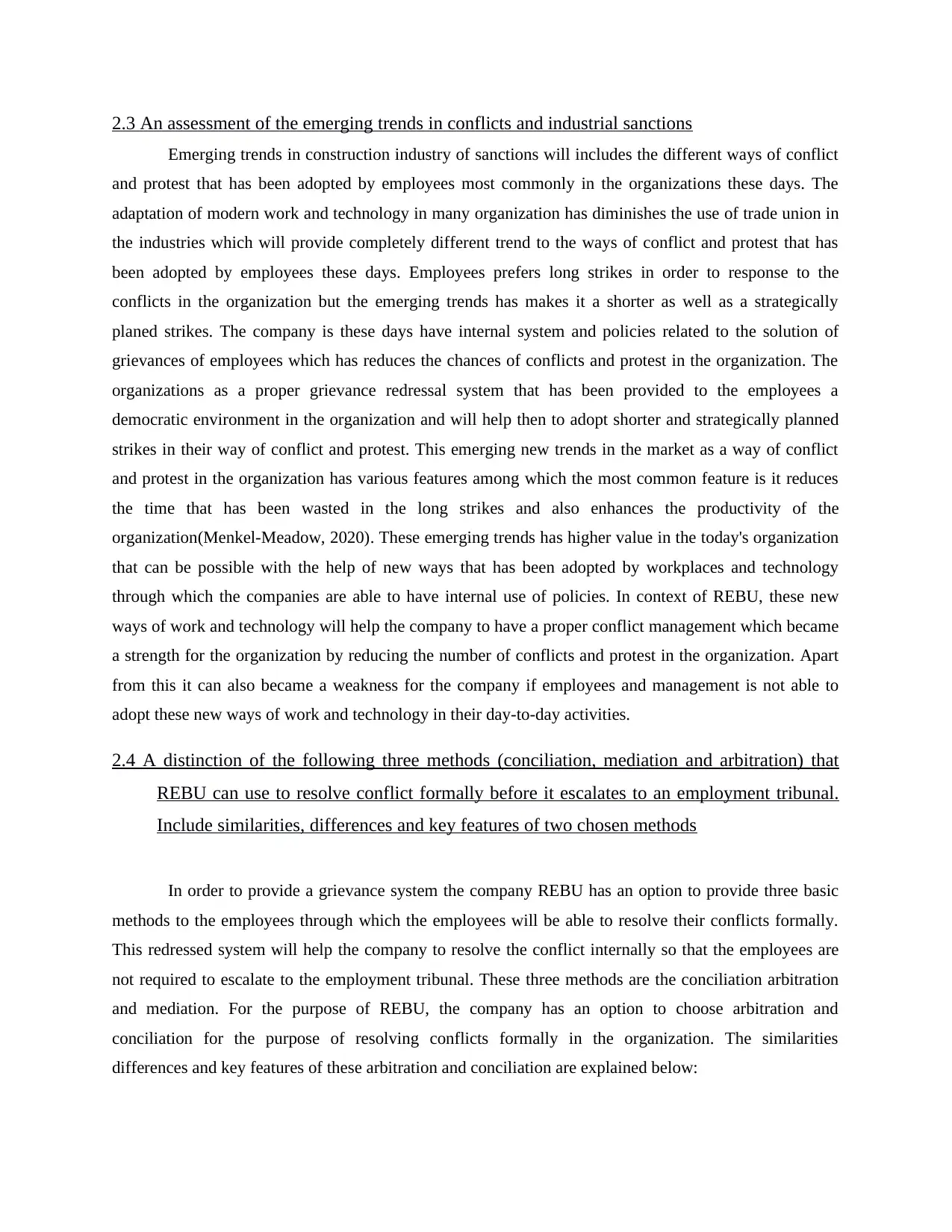
2.3 An assessment of the emerging trends in conflicts and industrial sanctions
Emerging trends in construction industry of sanctions will includes the different ways of conflict
and protest that has been adopted by employees most commonly in the organizations these days. The
adaptation of modern work and technology in many organization has diminishes the use of trade union in
the industries which will provide completely different trend to the ways of conflict and protest that has
been adopted by employees these days. Employees prefers long strikes in order to response to the
conflicts in the organization but the emerging trends has makes it a shorter as well as a strategically
planed strikes. The company is these days have internal system and policies related to the solution of
grievances of employees which has reduces the chances of conflicts and protest in the organization. The
organizations as a proper grievance redressal system that has been provided to the employees a
democratic environment in the organization and will help then to adopt shorter and strategically planned
strikes in their way of conflict and protest. This emerging new trends in the market as a way of conflict
and protest in the organization has various features among which the most common feature is it reduces
the time that has been wasted in the long strikes and also enhances the productivity of the
organization(Menkel-Meadow, 2020). These emerging trends has higher value in the today's organization
that can be possible with the help of new ways that has been adopted by workplaces and technology
through which the companies are able to have internal use of policies. In context of REBU, these new
ways of work and technology will help the company to have a proper conflict management which became
a strength for the organization by reducing the number of conflicts and protest in the organization. Apart
from this it can also became a weakness for the company if employees and management is not able to
adopt these new ways of work and technology in their day-to-day activities.
2.4 A distinction of the following three methods (conciliation, mediation and arbitration) that
REBU can use to resolve conflict formally before it escalates to an employment tribunal.
Include similarities, differences and key features of two chosen methods
In order to provide a grievance system the company REBU has an option to provide three basic
methods to the employees through which the employees will be able to resolve their conflicts formally.
This redressed system will help the company to resolve the conflict internally so that the employees are
not required to escalate to the employment tribunal. These three methods are the conciliation arbitration
and mediation. For the purpose of REBU, the company has an option to choose arbitration and
conciliation for the purpose of resolving conflicts formally in the organization. The similarities
differences and key features of these arbitration and conciliation are explained below:
Emerging trends in construction industry of sanctions will includes the different ways of conflict
and protest that has been adopted by employees most commonly in the organizations these days. The
adaptation of modern work and technology in many organization has diminishes the use of trade union in
the industries which will provide completely different trend to the ways of conflict and protest that has
been adopted by employees these days. Employees prefers long strikes in order to response to the
conflicts in the organization but the emerging trends has makes it a shorter as well as a strategically
planed strikes. The company is these days have internal system and policies related to the solution of
grievances of employees which has reduces the chances of conflicts and protest in the organization. The
organizations as a proper grievance redressal system that has been provided to the employees a
democratic environment in the organization and will help then to adopt shorter and strategically planned
strikes in their way of conflict and protest. This emerging new trends in the market as a way of conflict
and protest in the organization has various features among which the most common feature is it reduces
the time that has been wasted in the long strikes and also enhances the productivity of the
organization(Menkel-Meadow, 2020). These emerging trends has higher value in the today's organization
that can be possible with the help of new ways that has been adopted by workplaces and technology
through which the companies are able to have internal use of policies. In context of REBU, these new
ways of work and technology will help the company to have a proper conflict management which became
a strength for the organization by reducing the number of conflicts and protest in the organization. Apart
from this it can also became a weakness for the company if employees and management is not able to
adopt these new ways of work and technology in their day-to-day activities.
2.4 A distinction of the following three methods (conciliation, mediation and arbitration) that
REBU can use to resolve conflict formally before it escalates to an employment tribunal.
Include similarities, differences and key features of two chosen methods
In order to provide a grievance system the company REBU has an option to provide three basic
methods to the employees through which the employees will be able to resolve their conflicts formally.
This redressed system will help the company to resolve the conflict internally so that the employees are
not required to escalate to the employment tribunal. These three methods are the conciliation arbitration
and mediation. For the purpose of REBU, the company has an option to choose arbitration and
conciliation for the purpose of resolving conflicts formally in the organization. The similarities
differences and key features of these arbitration and conciliation are explained below:

Arbitration: Arbitration refers to the process in which employees as an option to submit a dispute by an
agreement that the parties will resolve the dispute with the help of one or more arbitrators who provides
binding decisions for the dispute(Feng, and Xie, 2020). It is a private dispute resolution system and is
consensual in nature.
Conciliation: Conciliation refers to an instrument that has been used to resolve the dispute out of the
court. Conservation is a voluntary instrument that can be adopted by organization to resolve disputes and
also is flexible confidential and a process that is interest based in nature.
3.1 The principles of the key legislation relating to unfair dismissal law and outline the process
an employer should follow with regard to with capability and misconduct issues within
REBU
Unfair dismissal refers to the situation in which employee is dismissed from the workplace with
unjust unreasonable or harsh manner. It has been provided that the dismissal of a qualifying employee
will be considered unfair until the employer has depicts the valid reason for such dismissal from the
organization. This principle provides for the five valid reasons in which the employee can be dismissed
from the organization in the unfair dismissal is on the grounds of capabilities any misconduct by the
employee by the reasons of redundancy and other substantial reasons which provides the dismissal a
justification by the employer. Affair the employer is required to give one of the following regions that are
potentially fair otherwise the dismissal will be deemed to be automatically on fair in the company. In case
of REBU, the managers of the company are required to follow a proper process in order to dismiss an
employee due to the reasons of their capabilities and misconduct issues within the company. The
managers are required to give the employee a proper notice off warning related to their capability is and
misconduct issues in the organization and provide them a suitable time to resolve this issue (Feng, and
Xie, 2020). In case of negligence from the employee the employer has an opportunity to dismiss the
employee from the job and in case of any grievances by the employee the tribunal will be able to identify
that either the dismissal is fair and unfair under the law.
3.3& 3.4 Two skills required to successfully handle grievances and disciplinary at work and the
importance of handling these effectively so REBU can avoid legal claims
In order to handle the grievances and disciplinary at workplace it is essential for the managers to
have effective skills that are required to manage these grievances. The two skills that are required to
handle grievances and disciplinary at work are given below:
agreement that the parties will resolve the dispute with the help of one or more arbitrators who provides
binding decisions for the dispute(Feng, and Xie, 2020). It is a private dispute resolution system and is
consensual in nature.
Conciliation: Conciliation refers to an instrument that has been used to resolve the dispute out of the
court. Conservation is a voluntary instrument that can be adopted by organization to resolve disputes and
also is flexible confidential and a process that is interest based in nature.
3.1 The principles of the key legislation relating to unfair dismissal law and outline the process
an employer should follow with regard to with capability and misconduct issues within
REBU
Unfair dismissal refers to the situation in which employee is dismissed from the workplace with
unjust unreasonable or harsh manner. It has been provided that the dismissal of a qualifying employee
will be considered unfair until the employer has depicts the valid reason for such dismissal from the
organization. This principle provides for the five valid reasons in which the employee can be dismissed
from the organization in the unfair dismissal is on the grounds of capabilities any misconduct by the
employee by the reasons of redundancy and other substantial reasons which provides the dismissal a
justification by the employer. Affair the employer is required to give one of the following regions that are
potentially fair otherwise the dismissal will be deemed to be automatically on fair in the company. In case
of REBU, the managers of the company are required to follow a proper process in order to dismiss an
employee due to the reasons of their capabilities and misconduct issues within the company. The
managers are required to give the employee a proper notice off warning related to their capability is and
misconduct issues in the organization and provide them a suitable time to resolve this issue (Feng, and
Xie, 2020). In case of negligence from the employee the employer has an opportunity to dismiss the
employee from the job and in case of any grievances by the employee the tribunal will be able to identify
that either the dismissal is fair and unfair under the law.
3.3& 3.4 Two skills required to successfully handle grievances and disciplinary at work and the
importance of handling these effectively so REBU can avoid legal claims
In order to handle the grievances and disciplinary at workplace it is essential for the managers to
have effective skills that are required to manage these grievances. The two skills that are required to
handle grievances and disciplinary at work are given below:
Secure Best Marks with AI Grader
Need help grading? Try our AI Grader for instant feedback on your assignments.
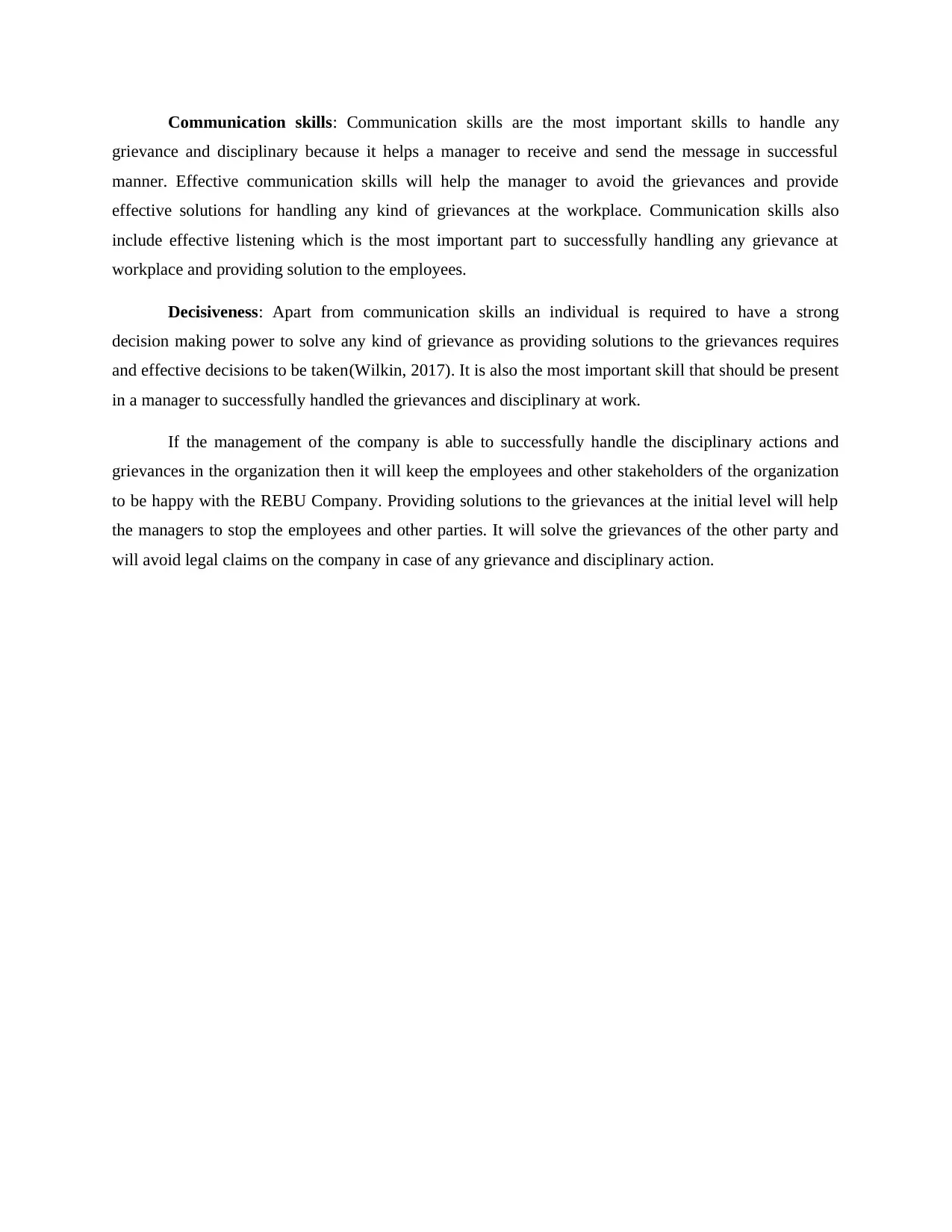
Communication skills: Communication skills are the most important skills to handle any
grievance and disciplinary because it helps a manager to receive and send the message in successful
manner. Effective communication skills will help the manager to avoid the grievances and provide
effective solutions for handling any kind of grievances at the workplace. Communication skills also
include effective listening which is the most important part to successfully handling any grievance at
workplace and providing solution to the employees.
Decisiveness: Apart from communication skills an individual is required to have a strong
decision making power to solve any kind of grievance as providing solutions to the grievances requires
and effective decisions to be taken(Wilkin, 2017). It is also the most important skill that should be present
in a manager to successfully handled the grievances and disciplinary at work.
If the management of the company is able to successfully handle the disciplinary actions and
grievances in the organization then it will keep the employees and other stakeholders of the organization
to be happy with the REBU Company. Providing solutions to the grievances at the initial level will help
the managers to stop the employees and other parties. It will solve the grievances of the other party and
will avoid legal claims on the company in case of any grievance and disciplinary action.
grievance and disciplinary because it helps a manager to receive and send the message in successful
manner. Effective communication skills will help the manager to avoid the grievances and provide
effective solutions for handling any kind of grievances at the workplace. Communication skills also
include effective listening which is the most important part to successfully handling any grievance at
workplace and providing solution to the employees.
Decisiveness: Apart from communication skills an individual is required to have a strong
decision making power to solve any kind of grievance as providing solutions to the grievances requires
and effective decisions to be taken(Wilkin, 2017). It is also the most important skill that should be present
in a manager to successfully handled the grievances and disciplinary at work.
If the management of the company is able to successfully handle the disciplinary actions and
grievances in the organization then it will keep the employees and other stakeholders of the organization
to be happy with the REBU Company. Providing solutions to the grievances at the initial level will help
the managers to stop the employees and other parties. It will solve the grievances of the other party and
will avoid legal claims on the company in case of any grievance and disciplinary action.
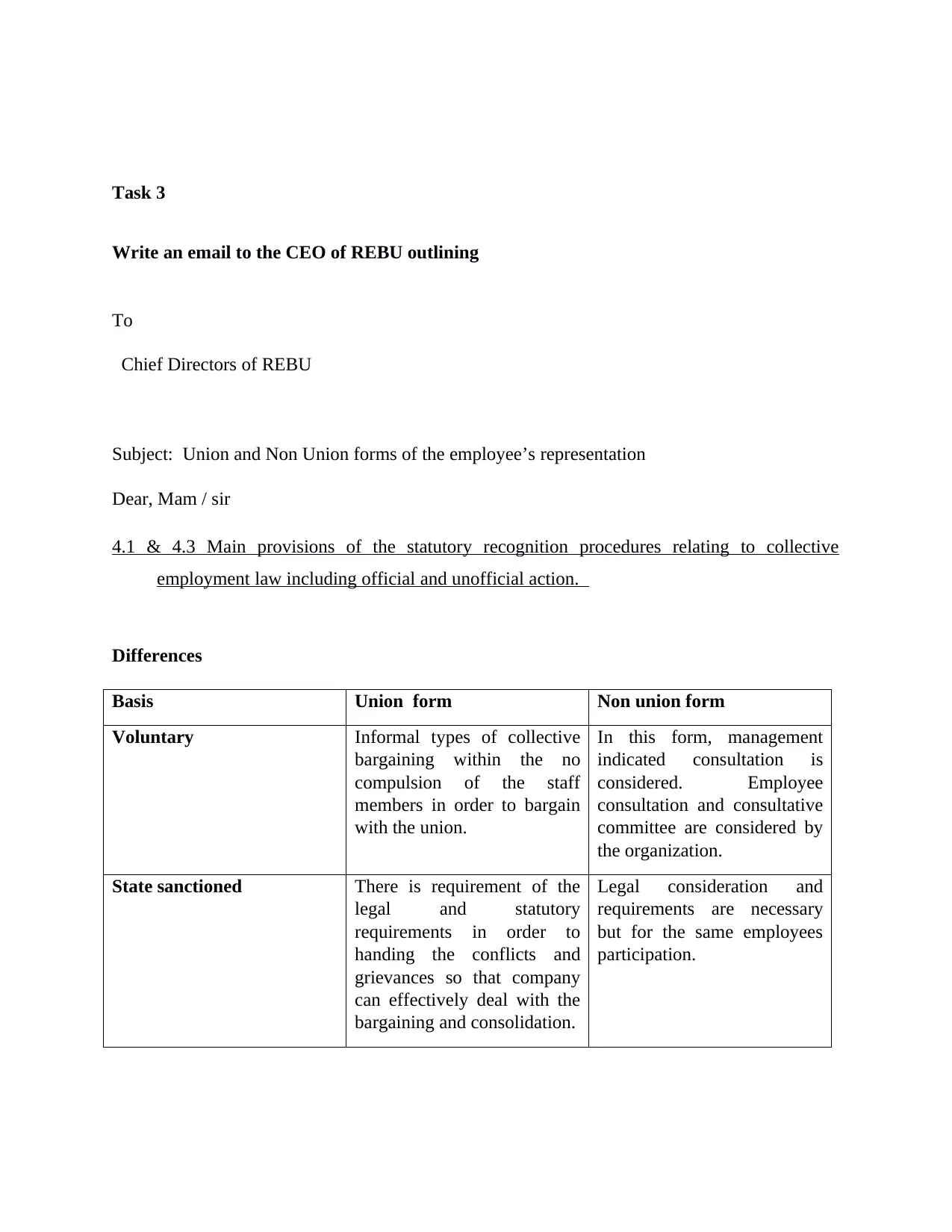
Task 3
Write an email to the CEO of REBU outlining
To
Chief Directors of REBU
Subject: Union and Non Union forms of the employee’s representation
Dear, Mam / sir
4.1 & 4.3 Main provisions of the statutory recognition procedures relating to collective
employment law including official and unofficial action.
Differences
Basis Union form Non union form
Voluntary Informal types of collective
bargaining within the no
compulsion of the staff
members in order to bargain
with the union.
In this form, management
indicated consultation is
considered. Employee
consultation and consultative
committee are considered by
the organization.
State sanctioned There is requirement of the
legal and statutory
requirements in order to
handing the conflicts and
grievances so that company
can effectively deal with the
bargaining and consolidation.
Legal consideration and
requirements are necessary
but for the same employees
participation.
Write an email to the CEO of REBU outlining
To
Chief Directors of REBU
Subject: Union and Non Union forms of the employee’s representation
Dear, Mam / sir
4.1 & 4.3 Main provisions of the statutory recognition procedures relating to collective
employment law including official and unofficial action.
Differences
Basis Union form Non union form
Voluntary Informal types of collective
bargaining within the no
compulsion of the staff
members in order to bargain
with the union.
In this form, management
indicated consultation is
considered. Employee
consultation and consultative
committee are considered by
the organization.
State sanctioned There is requirement of the
legal and statutory
requirements in order to
handing the conflicts and
grievances so that company
can effectively deal with the
bargaining and consolidation.
Legal consideration and
requirements are necessary
but for the same employees
participation.
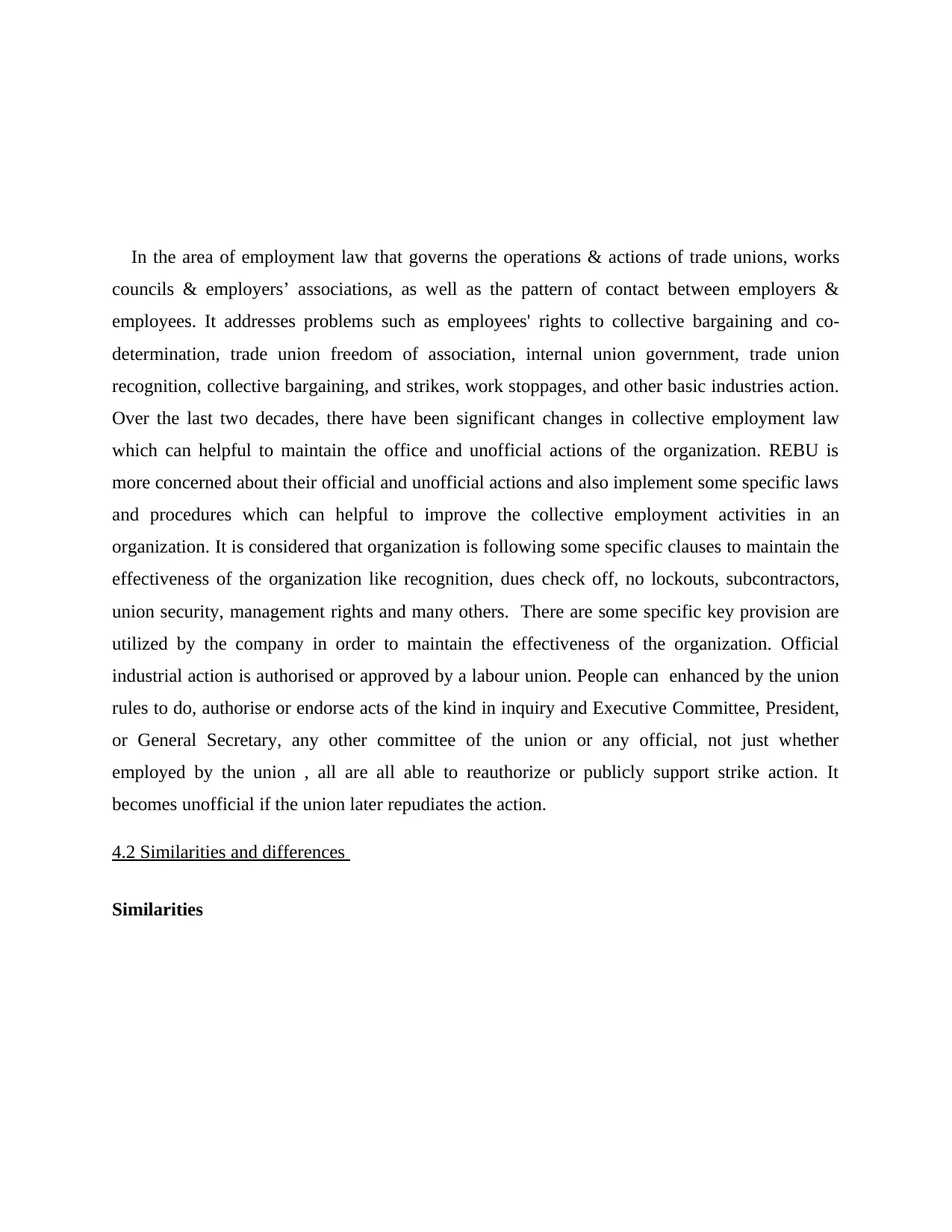
In the area of employment law that governs the operations & actions of trade unions, works
councils & employers’ associations, as well as the pattern of contact between employers &
employees. It addresses problems such as employees' rights to collective bargaining and co-
determination, trade union freedom of association, internal union government, trade union
recognition, collective bargaining, and strikes, work stoppages, and other basic industries action.
Over the last two decades, there have been significant changes in collective employment law
which can helpful to maintain the office and unofficial actions of the organization. REBU is
more concerned about their official and unofficial actions and also implement some specific laws
and procedures which can helpful to improve the collective employment activities in an
organization. It is considered that organization is following some specific clauses to maintain the
effectiveness of the organization like recognition, dues check off, no lockouts, subcontractors,
union security, management rights and many others. There are some specific key provision are
utilized by the company in order to maintain the effectiveness of the organization. Official
industrial action is authorised or approved by a labour union. People can enhanced by the union
rules to do, authorise or endorse acts of the kind in inquiry and Executive Committee, President,
or General Secretary, any other committee of the union or any official, not just whether
employed by the union , all are all able to reauthorize or publicly support strike action. It
becomes unofficial if the union later repudiates the action.
4.2 Similarities and differences
Similarities
councils & employers’ associations, as well as the pattern of contact between employers &
employees. It addresses problems such as employees' rights to collective bargaining and co-
determination, trade union freedom of association, internal union government, trade union
recognition, collective bargaining, and strikes, work stoppages, and other basic industries action.
Over the last two decades, there have been significant changes in collective employment law
which can helpful to maintain the office and unofficial actions of the organization. REBU is
more concerned about their official and unofficial actions and also implement some specific laws
and procedures which can helpful to improve the collective employment activities in an
organization. It is considered that organization is following some specific clauses to maintain the
effectiveness of the organization like recognition, dues check off, no lockouts, subcontractors,
union security, management rights and many others. There are some specific key provision are
utilized by the company in order to maintain the effectiveness of the organization. Official
industrial action is authorised or approved by a labour union. People can enhanced by the union
rules to do, authorise or endorse acts of the kind in inquiry and Executive Committee, President,
or General Secretary, any other committee of the union or any official, not just whether
employed by the union , all are all able to reauthorize or publicly support strike action. It
becomes unofficial if the union later repudiates the action.
4.2 Similarities and differences
Similarities
Paraphrase This Document
Need a fresh take? Get an instant paraphrase of this document with our AI Paraphraser
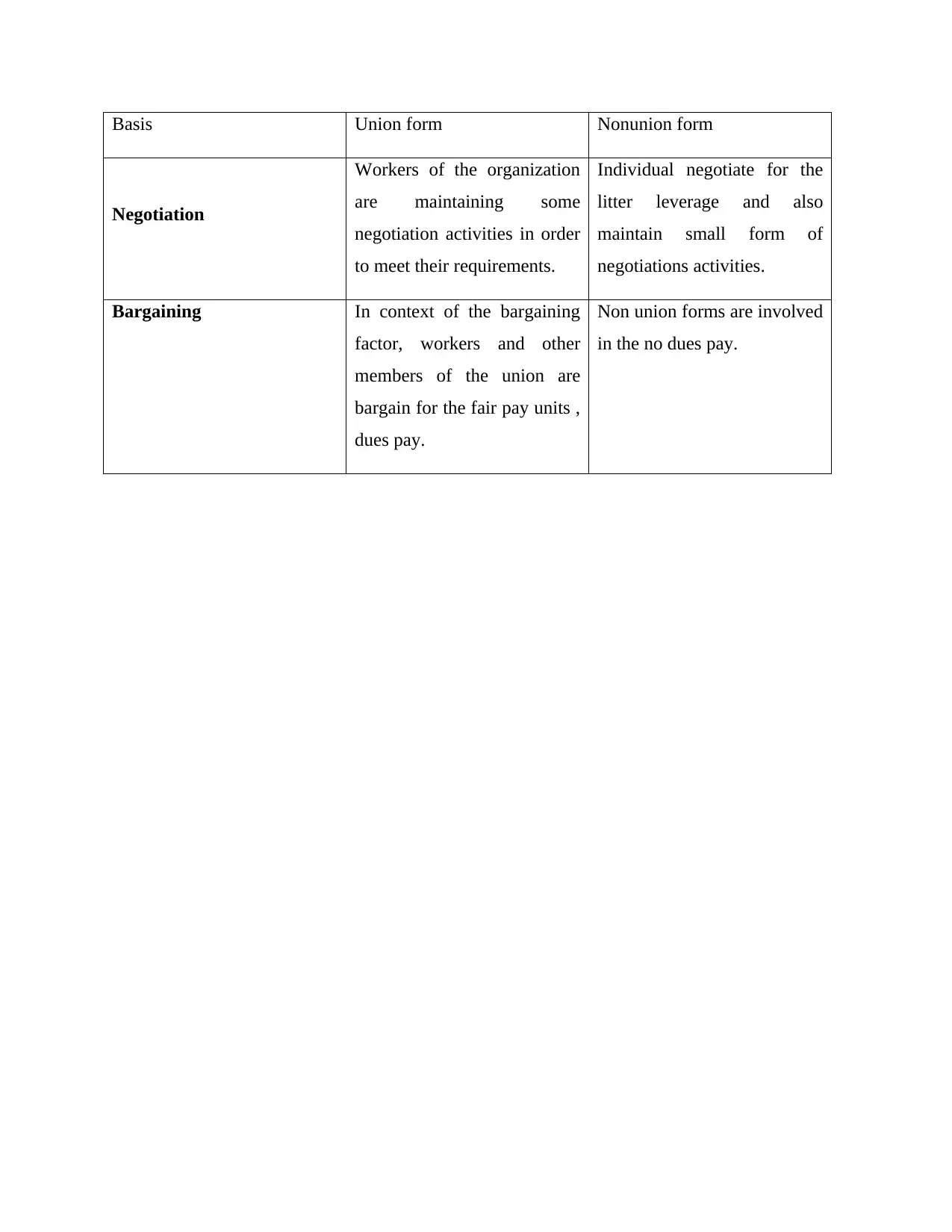
Basis Union form Nonunion form
Negotiation
Workers of the organization
are maintaining some
negotiation activities in order
to meet their requirements.
Individual negotiate for the
litter leverage and also
maintain small form of
negotiations activities.
Bargaining In context of the bargaining
factor, workers and other
members of the union are
bargain for the fair pay units ,
dues pay.
Non union forms are involved
in the no dues pay.
Negotiation
Workers of the organization
are maintaining some
negotiation activities in order
to meet their requirements.
Individual negotiate for the
litter leverage and also
maintain small form of
negotiations activities.
Bargaining In context of the bargaining
factor, workers and other
members of the union are
bargain for the fair pay units ,
dues pay.
Non union forms are involved
in the no dues pay.

References
Anthony‐McMann, P.E., Ellinger, A.D., Astakhova, M. and Halbesleben, J.R., 2017. Exploring
different operationalizations of employee engagement and their relationships with
workplace stress and burnout. Human Resource Development Quarterly, 28(2), pp.163-
195.
Brinsfield, C.T. and Edwards, M.S., 2020. Employee voice and silence in organizational
behavior. In Handbook of research on employee voice. Edward Elgar Publishing.
Butler, M., 2018. Labour Law in Great Britain. Kluwer Law International BV.
Cowan, R.L., Clayton, E. and Bochantin, J., 2021. Human resources as an important actor in
workplace bullying situations: Where we have been and where we should go. Pathways
of Job-related Negative Behaviour, pp.477-494.
Feng, J. and Xie, P., 2020. Is mediation the preferred procedure in labour dispute resolution
systems? Evidence from employer–employee matched data in China. Journal of
Industrial Relations, 62(1), pp.81-103.
Holland, P., Cooper, B. and Sheehan, C., 2017. Employee voice, supervisor support, and
engagement: The mediating role of trust. Human Resource Management, 56(6), pp.915-
929.
Marchington, M., Wilkinson, A., Donnelly, R. and Kynighou, A., 2016. Human resource
management at work. Kogan Page Publishers.
Mazzei, A., 2018. Employee engagement. The International Encyclopedia of Strategic
Communication, pp.1-6.
Menkel-Meadow, C., 2020. Hybrid and mixed dispute resolution processes: integrities of process
pluralism. In Comparative Dispute Resolution. Edward Elgar Publishing.
Nash, D. and Hann, D., 2020. Strategic conflict management? A study of workplace dispute
resolution in Wales. ILR Review, 73(2), pp.411-430.
Opoku‐Dakwa, A., Chen, C.C. and Rupp, D.E., 2018. CSR initiative characteristics and
employee engagement: An impact‐based perspective. Journal of Organizational
Behavior, 39(5), pp.580-593.
Othman, A.K., Mahmud, Z., Noranee, S. and Noordin, F., 2018, March. Measuring employee
happiness: Analyzing the dimensionality of employee engagement. In International
Conference on Kansei Engineering & Emotion Research (pp. 863-869). Springer,
Singapore.
Rouméas, É., 2020. Religious Diversity in the Workplace: The Case for Alternative Dispute
Resolution. Political Studies, 68(1), pp.207-223.
Anthony‐McMann, P.E., Ellinger, A.D., Astakhova, M. and Halbesleben, J.R., 2017. Exploring
different operationalizations of employee engagement and their relationships with
workplace stress and burnout. Human Resource Development Quarterly, 28(2), pp.163-
195.
Brinsfield, C.T. and Edwards, M.S., 2020. Employee voice and silence in organizational
behavior. In Handbook of research on employee voice. Edward Elgar Publishing.
Butler, M., 2018. Labour Law in Great Britain. Kluwer Law International BV.
Cowan, R.L., Clayton, E. and Bochantin, J., 2021. Human resources as an important actor in
workplace bullying situations: Where we have been and where we should go. Pathways
of Job-related Negative Behaviour, pp.477-494.
Feng, J. and Xie, P., 2020. Is mediation the preferred procedure in labour dispute resolution
systems? Evidence from employer–employee matched data in China. Journal of
Industrial Relations, 62(1), pp.81-103.
Holland, P., Cooper, B. and Sheehan, C., 2017. Employee voice, supervisor support, and
engagement: The mediating role of trust. Human Resource Management, 56(6), pp.915-
929.
Marchington, M., Wilkinson, A., Donnelly, R. and Kynighou, A., 2016. Human resource
management at work. Kogan Page Publishers.
Mazzei, A., 2018. Employee engagement. The International Encyclopedia of Strategic
Communication, pp.1-6.
Menkel-Meadow, C., 2020. Hybrid and mixed dispute resolution processes: integrities of process
pluralism. In Comparative Dispute Resolution. Edward Elgar Publishing.
Nash, D. and Hann, D., 2020. Strategic conflict management? A study of workplace dispute
resolution in Wales. ILR Review, 73(2), pp.411-430.
Opoku‐Dakwa, A., Chen, C.C. and Rupp, D.E., 2018. CSR initiative characteristics and
employee engagement: An impact‐based perspective. Journal of Organizational
Behavior, 39(5), pp.580-593.
Othman, A.K., Mahmud, Z., Noranee, S. and Noordin, F., 2018, March. Measuring employee
happiness: Analyzing the dimensionality of employee engagement. In International
Conference on Kansei Engineering & Emotion Research (pp. 863-869). Springer,
Singapore.
Rouméas, É., 2020. Religious Diversity in the Workplace: The Case for Alternative Dispute
Resolution. Political Studies, 68(1), pp.207-223.
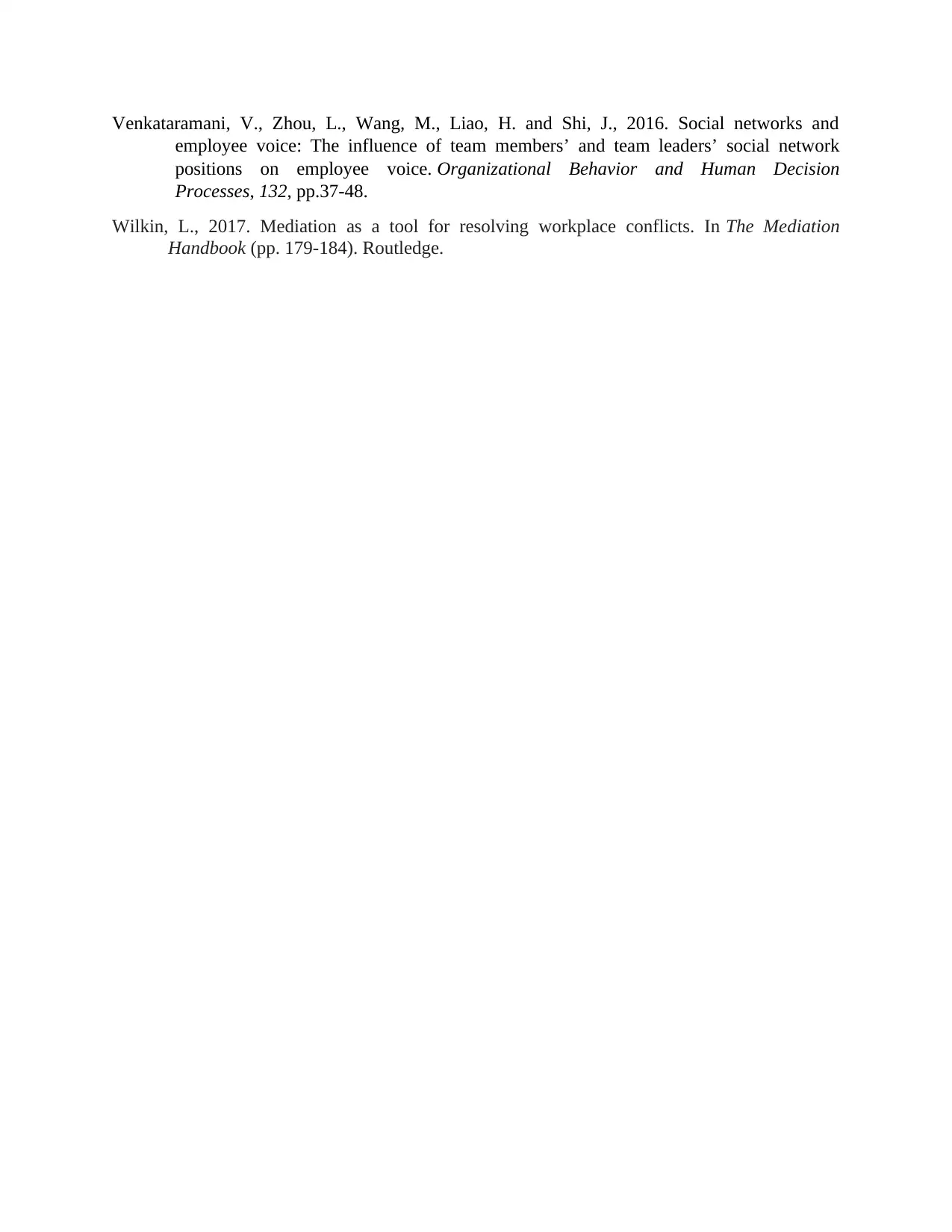
Venkataramani, V., Zhou, L., Wang, M., Liao, H. and Shi, J., 2016. Social networks and
employee voice: The influence of team members’ and team leaders’ social network
positions on employee voice. Organizational Behavior and Human Decision
Processes, 132, pp.37-48.
Wilkin, L., 2017. Mediation as a tool for resolving workplace conflicts. In The Mediation
Handbook (pp. 179-184). Routledge.
employee voice: The influence of team members’ and team leaders’ social network
positions on employee voice. Organizational Behavior and Human Decision
Processes, 132, pp.37-48.
Wilkin, L., 2017. Mediation as a tool for resolving workplace conflicts. In The Mediation
Handbook (pp. 179-184). Routledge.
1 out of 16
![[object Object]](/_next/static/media/star-bottom.7253800d.svg)




